Looking for a nutritious, delicious, and diabetes-friendly pasta recipe that will leave you craving for more? Then look no further than this quick and flavorful tuna pesto pasta recipe!

Tuna pasta was always a staple salad rolled out in the summer months and at BBQ’s when I was growing up but I think it’s about time that it had 21st Century update. Combining a family favourite of pesto pasta with the beloved tuna pasta this tuna pesto pasta will definitely be a recipe that becomes a firm favourite for you too.
This recipe has had a few tweaks to make it healthy, nutritious, gluten-free and great for diabetics who need to consider the impact of food on their blood glucose levels.
In this article, we will explore the secrets to perfecting tuna pesto pasta, the health benefits of the ingredients, tips to enhance its flavour, and a step-by-step guide on how to make it. So get ready to impress your taste buds with this unique and flavorful dish that will leave you craving for more.

The Secret to Perfect Tuna Pesto Pasta
This recipe is packed with flavour and health benefits and really makes a brilliant quick and easy mid-week meal that is also kind on blood sugar levels. But Why is this the perfect Tuna Pesto Pasta?
The reason that this recipe is so good is that it has the right combination of ingredients. The creamy and nutty flavour of the basil pesto with added peas, works so well with the meaty and slightly salty taste of tuna. And let’s not forget the addition of the succulent cherry tomatoes, which provide a crunchy burst of sweetness and acidity. It really is a perfect balance.
But possibly the most important ingredient is the pasta itself.
Blood Sugar Friendly Pasta

This recipe uses a gluten-free pasta made from brown rice. It really is the ideal choice as its slight nuttiness pairs well with the other flavours.
But best of all it is gentler on blood sugar levels.
Regular white pasta can have quite an impact on blood sugars due to the refinement of the wheat. So we have found that making the switch to either a wholegrain, lentil, pea or brown rice pasta has:
- had less of an impact on levels
- reduced insulin requirements for these meals
- and therefore reduced the error rate
To find out more about other changes we have made to help us better manage type 1 diabetes then check out my article all about Our Diabetes Toolkit

Our Diabetes Management Toolkit
Living with and/or caring for a person with type 1 diabetes is demanding, which is why it’s so important to create a diabetes management toolkit that can help you every day.
What you will need to make Tuna Pasta Pesto

Brown Rice Pasta
- A wholefood pasta, which is a good source of fibre, minerals and antioxidants
- I use Brown Rice Fusilli from Sainsbury’s. But I also like the Penne at Waitrose or Doves Farm Penne & Totiglioni at Ocado
- You could substitute the brown rice pasta for a wholegrain, pea or lentil pasta
Basil Pesto
- A delicious sauce of crushed basil, parmesan garlic and oil.
- I used a shop-bought pesto in this recipe but read the labels as some are not made with the best ingredients. A little more expensive, but I like this simple Green Basil Pesto from M&S
- You could also choose to make a homemade pesto.
Frozen Peas
- Tiny little nutritious powerhouses that are rich in lots of essential vitamins, minerals, fibre and plant protein
- Freezing the peas as soon as they are picked also helps to keep the nutrients intact
Tuna
- A great source of protein and omega-3 fatty acids, which are essential for heart health and supporting the brain.
- I use tuna that has been canned in springwater
Cherry Tomatoes
- Rich in Lycopene and vitamins A, C & E
Equipment
Saucepan
Chopping Board and Knife
How to make Tuna Pasta Pesto
This really is an incredibly easy meal to make. It’s particularly handy when you need a quick nutritious mid-week meal on the table in under 30 minutes.
Here is the step by step guide:
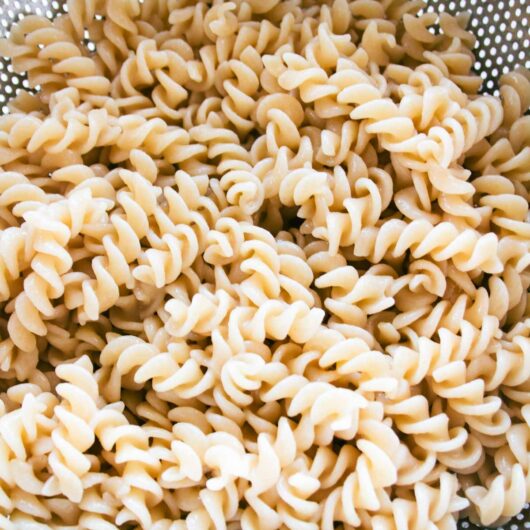
Step 1:
Start by heating your pan of water to cook the pasta on the hob. When the water is boiling add your pasta and cook as per packet instructions.

Step 2:
Whilst the pasta is cooking, it’s time to make the pesto. Start by defrosting your peas in the microwave. I find 2 minutes on high with a little water in the bowl usually does the trick.
Then using the small blender blitz your pesto with 250g of the peas to make a vibrant green sauce. Keeping the rest of your peas to one side.

Step 3:
Drain your pasta when cooked reserving a little of the pasta water. Add the drained pasta back into the saucepan with 3-4 tbsp of the pasta water.
Then mix through the pea pesto adding a little bit more pasta water if needed, until everything is well combined.
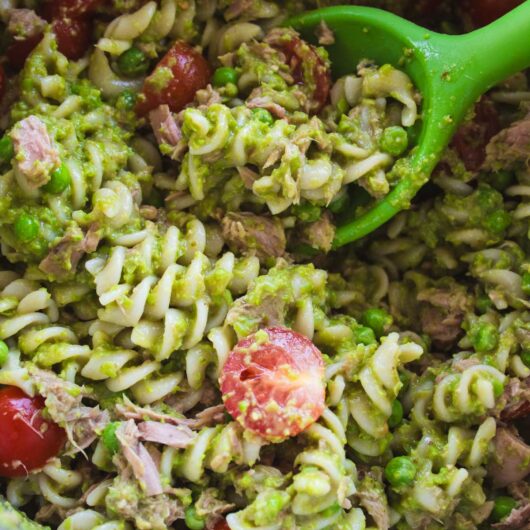
Step 4:
Finally, stir through the tomatoes, the rest of the peas and tinned tuna with plenty of pepper and a little salt.
You can gently heat everything through for a hotter dish or just serve straight away.
Recipe variations and tips
To take your tuna pesto pasta to the next level, here are some tips that can really enhance its flavour.
Add some freshly squeezed lemon juice – This adds a little tanginess and freshness that really lifts this dish.
Add a good drizzle of extra-virgin olive oil – This will add some extra richness and depth to the pasta, making it even more delicious.
Additional flavours to add – maybe add some chopped garlic, extra fresh basil or red pepper flakes for a bit of heat.
The best way though to ensure your tuna pesto pasta has the most enhanced flavours is to use high-quality ingredients. This will make a big difference in the overall taste of the dish and ensure that you get the most out of every bite.
serving suggestions
This tasty dish is fantastic eaten either hot or cold, as a main, light lunch or as a side. Here are some of the ways we enjoy eating it.
As a main meal – Serve with extra veg on the side though like; Herby Green Bean Salad or Pesto Roasted Green Vegetables or Zesty Pan Fried Courgettes

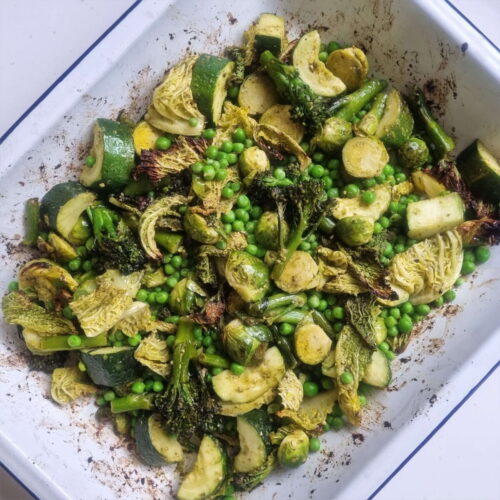

As a lighter lunch – Serve on top of a fresh bowl of leafy greens
As a side dish– served cold this makes a great BBQ side salad or picnic dish
How to store
Leftovers or if you are making this tuna pesto pasta in advance can be stored in the fridge. Just pop it into an airtight container for up to 4 days. Just make sure that the pasta is completely cool before putting it in the fridge.

Diabetes Note
This tuna pesto pasta uses a gluten-free pasta made from brown rice. It really is the ideal choice as we have found it to be much gentler on blood sugar levels.
One extra note is that we have also found that we have to use a different carb ratio for this pasta as my daughter doesn’t seem to need as much insulin as she would for a wholegrain or white pasta!
Carb Counting
The overall carb count for this tuna pasta pesto as a main meal and based on the ingredients we would count for is:
- 700g cooked weight of Sainburys Brown Rice Fusilli = 282.4g of carbs
Divide this by the serving size, 4 – 282/4 = 71g of carb per portion
However, for a more accurate way to carb count, weigh the total amount of tuna pesto pasta when it is made and then use the following formula:

Not only is this more accurate but then you can easily adjust your portion weight depending on how you are eating this dish.
Please note this carb count amount per portion is based on the standard ingredients listed above and may differ depending on what you use and how much you choose to eat.


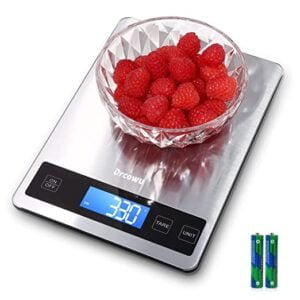


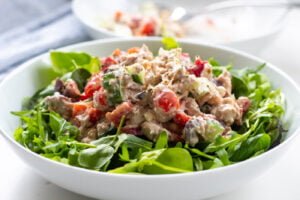
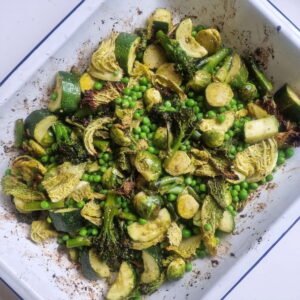


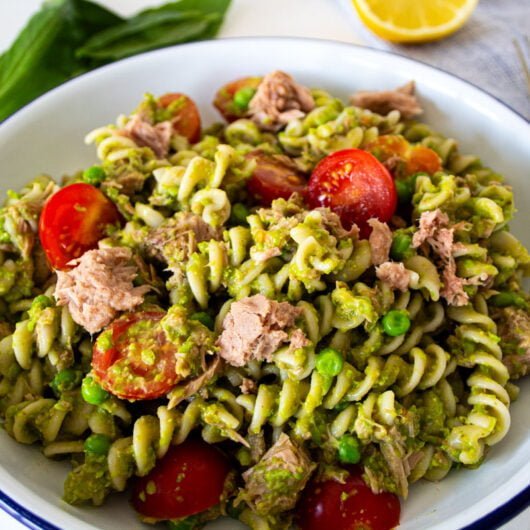








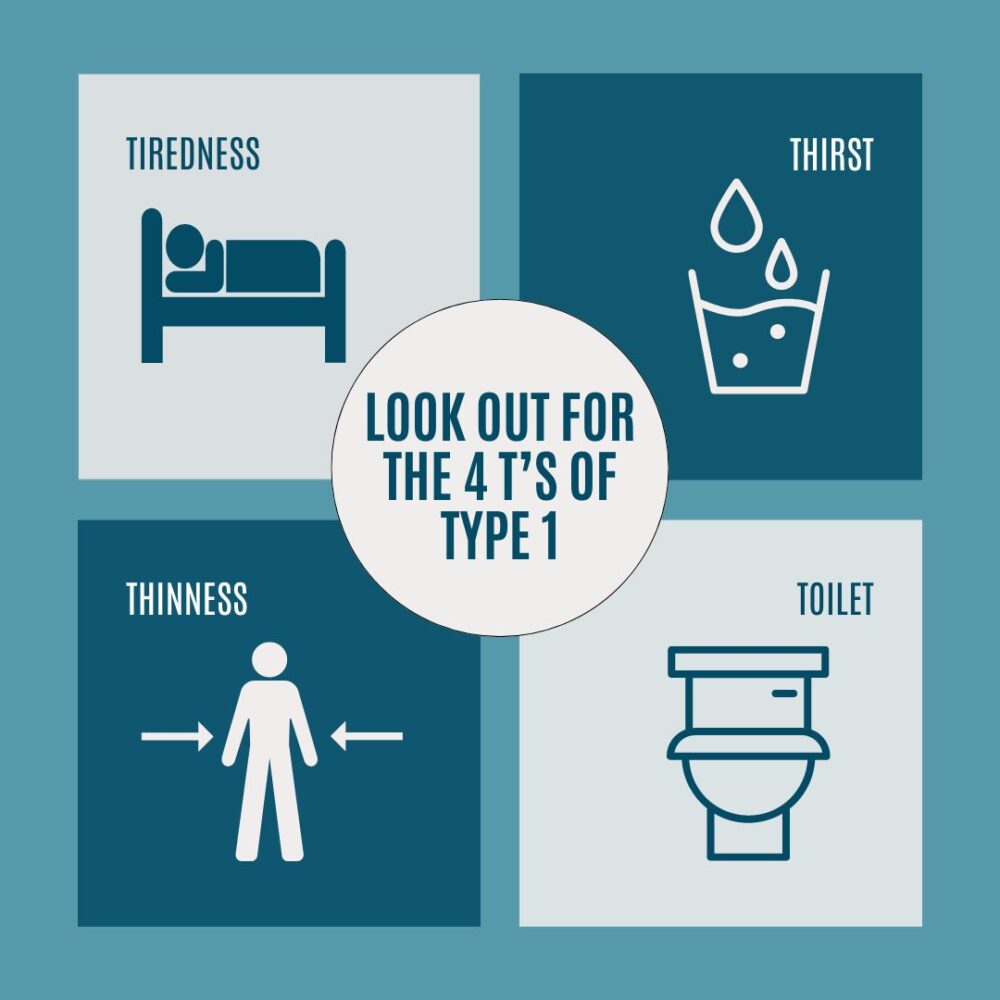
Leave a Reply